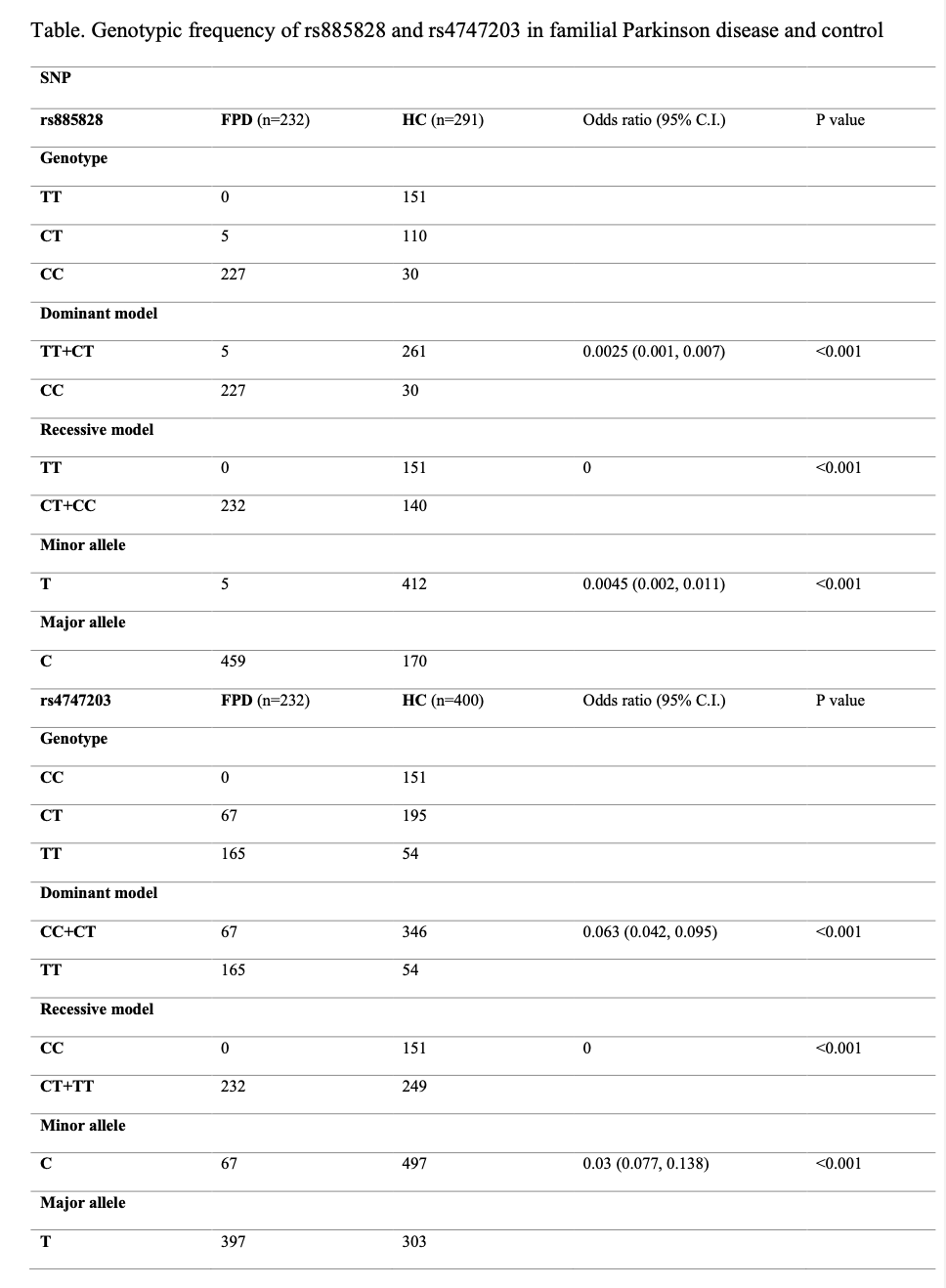Category: Parkinson's Disease: Genetics
Objective: To investigate the role of the PSAP gene in PD patients in Taiwan, including familial PD and early-onset Parkinson’s disease.
Background: Mutations in the saposin D domain of prosaposin gene (PSAP), a sphingolipid activator affecting lysosomal function, have been identified in familial Parkinson’s disease (PD). Two intronic variants (rs4747203, T>C, and rs885828, C>T) around saposin D domain were also significantly correlated with increased risk of sporadic PD (SPD). However, the studies on the effect of PSAP variants in PD risk have conflicting results.
Method: Patients of FPD with autosomal dominant (AD) and recessive inheritance (AR), and patients of EOPD with the age of onset less than 50 years old were enrolled at the National Taiwan University Hospital. The whole length of PSAP exons and introns was examined by Sanger sequencing. The allele frequency of rs885828 and rs4747203 between patients and healthy controls (HC) from Taiwan biobank was analyzed using the chi-squared test.
Results: Total 480 patients, including 184 FPD (118 AD, 66 AR) and 296 EOPD were enrolled. Exon sequencing were done in all patients and two novel exonic variants (p.A146E and p.Y248C) were identified. In the analysis of rs885828 and rs4747203, the allelic frequency intronic variants were significantly lower in overall PD group than HC (rs885828, p < 0.001, Odds ratio (OR) = 0.0045, 95% confidence interval (CI) = 0.002-0.011]; rs4747203, p < 0.001, OR = 0.03, 95% CI = 0.077-0.14). The protective effects are also shown in both dominant and recessive inheritance model. (Table)
Conclusion: Two intronic variants in PSAP are associated with a protective effect in FPD and EOPD, indicating a more universal role of PSAP in the pathogenesis of PD other than sporadic cases. Further large-scale association studies and lysosomal functional studies are warranted.
References: 1. Bloem BR, Okun MS, Klein C. Parkinson’s disease. The Lancet. 2021;397:2284-2303. doi: 10.1016/S0140-6736(21)00218-X
2. Chu YT, Tai CH, Lin CH, Wu RM. Updates on the Genetics of Parkinson’s Disease: Clinical Implications and Future Treatment. Acta Neurol Taiwan. 2021;30(3):83-93. doi:
3. Klein AD, Mazzulli JR. Is Parkinson’s disease a lysosomal disorder? Brain. 2018;141:2255-2262. doi: 10.1093/brain/awy147
4. Sardi SP, Viel C, Clarke J, Treleaven CM, Richards AM, Park H, Olszewski MA, Dodge JC, Marshall J, Makino E, et al. Glucosylceramide synthase inhibition alleviates aberrations in synucleinopathy models. Proc Natl Acad Sci U S A. 2017;114:2699-2704. doi: 10.1073/pnas.1616152114
5. Lee JS, Kanai K, Suzuki M, Kim WS, Yoo HS, Fu Y, Kim DK, Jung BC, Choi M, Oh KW, et al. Arylsulfatase A, a genetic modifier of Parkinson’s disease, is an alpha-synuclein chaperone. Brain. 2019;142:2845-2859. doi: 10.1093/brain/awz205
6. Oji Y, Hatano T, Ueno SI, Funayama M, Ishikawa KI, Okuzumi A, Noda S, Sato S, Satake W, Toda T, et al. Variants in saposin D domain of prosaposin gene linked to Parkinson’s disease. Brain. 2020;143:1190-1205. doi: 10.1093/brain/awaa064
7. Kishimoto Y, Hiraiwa M, O’Brien JS. Saposins: structure, function, distribution, and molecular genetics. J Lipid Res. 1992;33:1255-1267. doi:
8. Tamargo RJ, Velayati A, Goldin E, Sidransky E. The role of saposin C in Gaucher disease. Molecular Genetics and Metabolism. 2012;106:257-263. doi: https://doi.org/10.1016/j.ymgme.2012.04.024
9. Cesani M, Lorioli L, Grossi S, Amico G, Fumagalli F, Spiga I, Filocamo M, Biffi A. Mutation Update of ARSA and PSAP genes causing Metachromatic Leukodystrophy. Human mutation. 2015;37. doi: 10.1002/humu.22919
10. Chao YX, Lee B, Ng EY, Lian MM, Chew EGY, Tandiono M, Li Z, Khor CC, Kumar P, Tan LCS, et al. Association analysis of PSAP variants in Parkinson’s disease patients. Brain. 2021;144:e9. doi: 10.1093/brain/awaa358
11. Foo JN, Chew EGY, Chung SJ, Peng R, Blauwendraat C, Nalls MA, Mok KY, Satake W, Toda T, Chao YX, et al. Identification of Risk Loci for Parkinson Disease in Asians and Comparison of Risk Between Asians and Europeans A Genome-Wide Association Study. Jama Neurol. 2020;77:746-754. doi: 10.1001/jamaneurol.2020.0428
12. Lin CH, Chen PL, Tai CH, Lin HI, Chen CS, Chen ML, Wu RM. A clinical and genetic study of early-onset and familial parkinsonism in taiwan: An integrated approach combining gene dosage analysis and next-generation sequencing. Mov Disord. 2019;34:506-515. doi: 10.1002/mds.27633
13. Richards S, Aziz N, Bale S, Bick D, Das S, Gastier-Foster J, Grody WW, Hegde M, Lyon E, Spector E, et al. Standards and guidelines for the interpretation of sequence variants: a joint consensus recommendation of the American College of Medical Genetics and Genomics and the Association for Molecular Pathology. Genet Med. 2015;17:405-424. doi: 10.1038/gim.2015.30
14. Madeira F, Park YM, Lee J, Buso N, Gur T, Madhusoodanan N, Basutkar P, Tivey ARN, Potter SC, Finn RD, et al. The EMBL-EBI search and sequence analysis tools APIs in 2019. Nucleic Acids Res. 2019;47:W636-W641. doi: 10.1093/nar/gkz268
15. Sham PC, Purcell SM. Statistical power and significance testing in large-scale genetic studies. Nat Rev Genet. 2014;15:335-346. doi: 10.1038/nrg3706
To cite this abstract in AMA style:
YT. Chu, MC. Kuo, YA. Su, RM. Wu. Polymorphisms in Prosaposin gene are associated with familial and early-onset Parkinson’s disease: A case-control association study and meta-analysis [abstract]. Mov Disord. 2022; 37 (suppl 2). https://www.mdsabstracts.org/abstract/polymorphisms-in-prosaposin-gene-are-associated-with-familial-and-early-onset-parkinsons-disease-a-case-control-association-study-and-meta-analysis/. Accessed January 2, 2026.« Back to 2022 International Congress
MDS Abstracts - https://www.mdsabstracts.org/abstract/polymorphisms-in-prosaposin-gene-are-associated-with-familial-and-early-onset-parkinsons-disease-a-case-control-association-study-and-meta-analysis/

